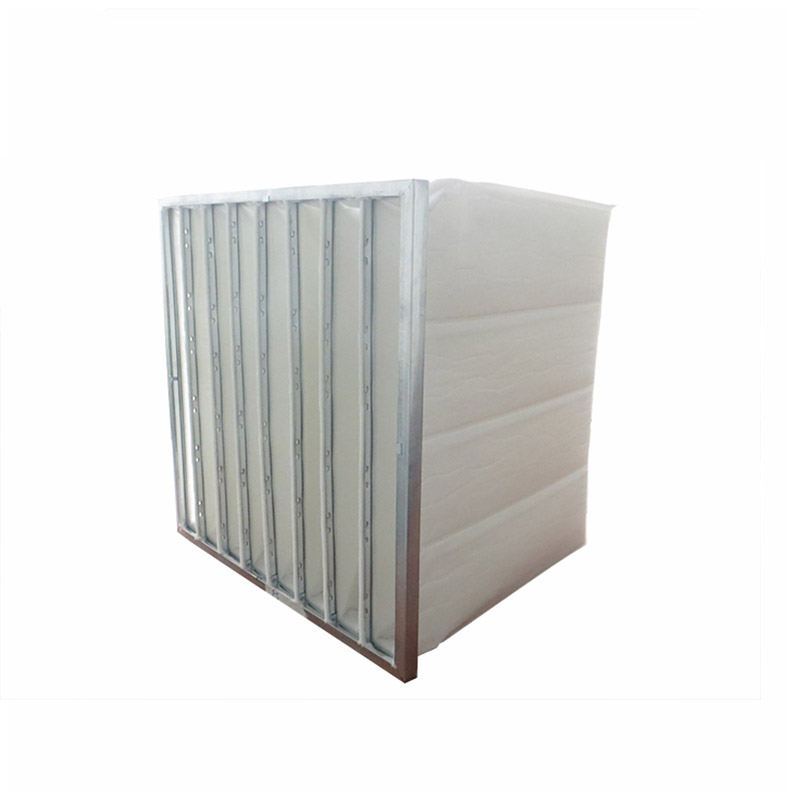Factors that determine the efficiency of pocket filters
 Mar 14, 2023|
Mar 14, 2023| View:258
View:258Pocket filters are widely used in air filtration systems. They are designed to capture airborne particles, such as dust, mold spores and pollen, while allowing clean air to pass through. The efficiency of pocket filters depends on several factors that affect their performance and longevity. In this article, we explore the key factors that determine a pocket filter's efficiency and how to optimize its performance for a clean and healthy indoor environment.
A pocket filter consists of a series of synthetic fiber bags arranged in a V-shaped configuration. This design maximizes the surface area of the filter, allowing for higher particle retention capacity. The pockets are sewn together and mounted on a metal frame, allowing for easy installation and replacement. The efficiency of a pocket filter depends primarily on the type of fiber used in the filter, the MERV rating and the operating conditions.

1. Fiber type of the pocket filter.
The type of fiber used in a pocket filter greatly affects the performance of the filter in capturing and retaining airborne particles. Synthetic fibers such as polypropylene and polyester are commonly used in pocket filters due to their high strength, durability and moisture resistance. These fibers have a high surface area to volume ratio, allowing them to capture smaller particles and retain them for longer periods of time. pocket filters made from synthetic fibers have a high dust holding capacity and are resistant to abrasion, tearing and chemical attack.
2. pocket filter MERV rating.
MERV rating is a measure of a filter's ability to capture air particles of different sizes. It represents the lowest efficiency reporting value and ranges from 1 to 16. the higher the MERV rating, the more efficient the filter is at capturing smaller particles. pocket filters with a MERV rating of 11 or higher are very efficient, capturing particles as small as 0.3 microns. As the MERV rating increases, so does the airflow resistance, which can lead to reduced indoor air quality and increased energy costs.
3. Operating conditions also play an important role in the efficiency of the pocket filter.
The airflow rate, temperature and humidity of the air passing through the filter can affect its performance and life. High airflow rates result in faster filter saturation, while low airflow rates result in lower particle capture rates. The temperature and humidity of the air can also affect the performance of the filter. High humidity levels can cause filters to become wet, which reduces their ability to capture particles. High air temperatures can cause the filter's fibers to break down more quickly, thereby shortening its life and efficiency.
To optimize the efficiency of pocket filters, regular maintenance and replacement is essential. pocket filters should be inspected and cleaned regularly to ensure they are free of debris and other contaminants. Clogged or dirty filters can restrict airflow, reduce filter efficiency, and increase energy costs. pocket filters should be replaced according to the manufacturer's recommended schedule, or when they become saturated with airborne particles. The frequency of filter replacement may vary depending on operating conditions, such as the level of air contaminants and airflow rate.
In summary, pocket filters are effective devices for capturing airborne particles, such as dust and pollen. Their efficiency depends on several factors, including fiber type, MERV rating, and operating conditions. Synthetic fibers with high MERV ratings are most effective at capturing small particles, they have a high dust holding capacity and are resistant to tearing and chemical attack. The performance of pocket filters is also affected by the airflow rate, temperature and humidity of the air passing through them. Regular cleaning and maintenance, as well as changing filters according to the manufacturer's recommendations, will ensure that pocket filters work efficiently and provide clean, healthy indoor air quality. If you need more detailed information, please feel free to contact us!



 qr315@cooca.com.cn
qr315@cooca.com.cn
